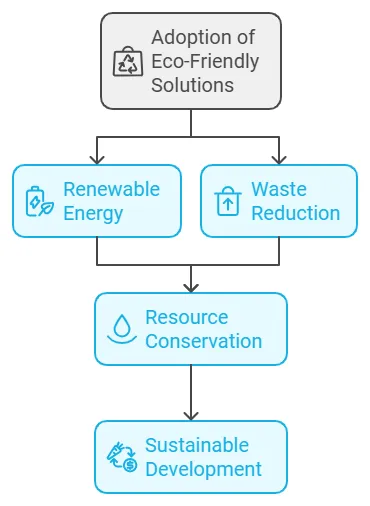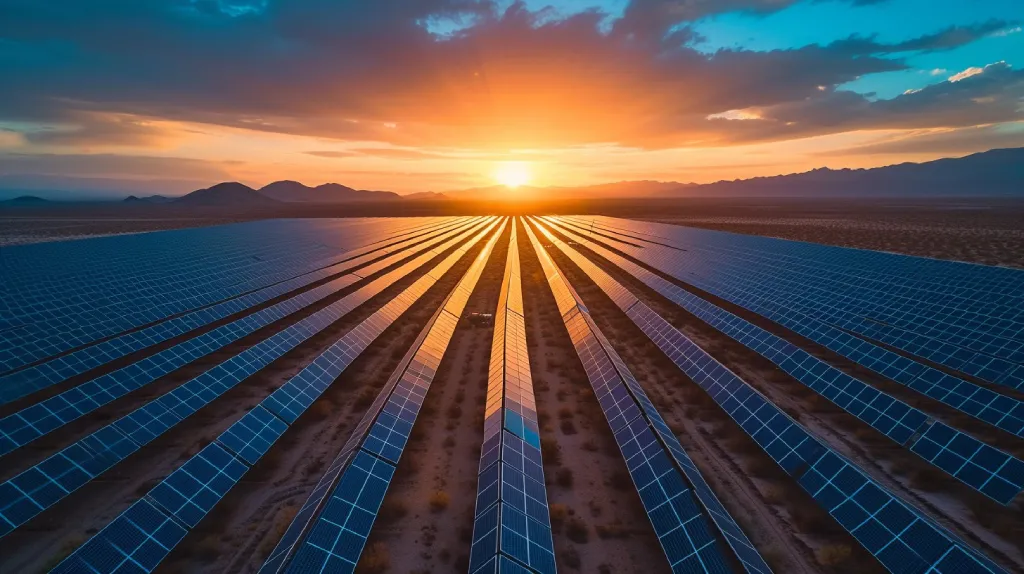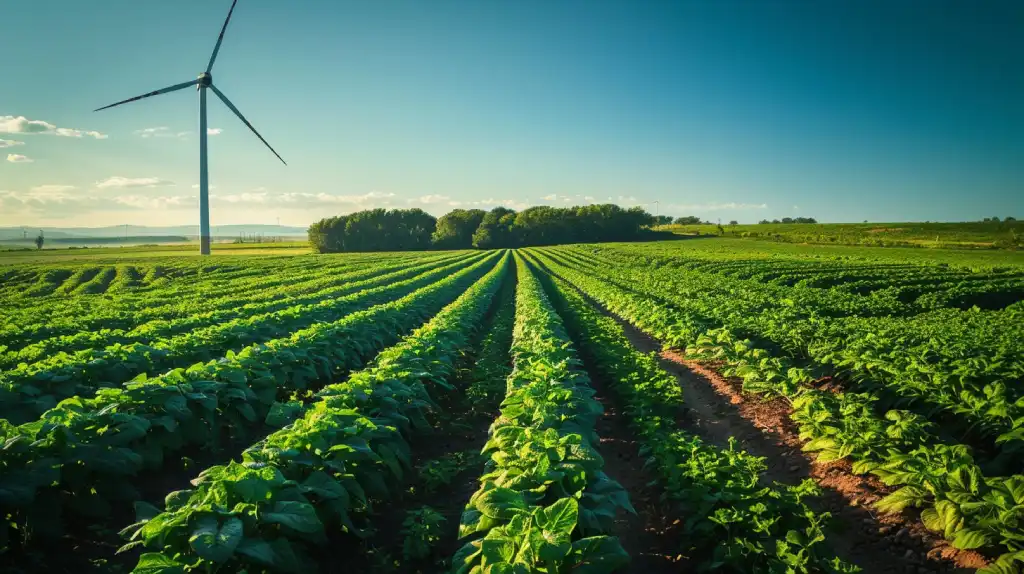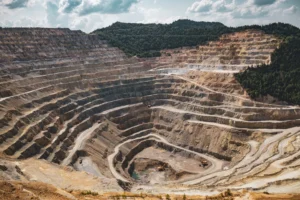Sustainable solutions are answers to the continuously growing environmental, social, and economic problems that the world is experiencing today. Eco-friendly solutions are urgently needed to protect our planet and society as climate change worsens and natural resources decrease.
Today, from renewable energy to reducing waste, green solutions are becoming more common in many industries. This promises a future where resource conservation is key to development.

Renewable Energy – Powering a Clean Future

A very effective climate-friendly measure is to switch from fossil fuels to renewable energy. Renewable energy, mainly in terms of solar, wind, and hydroelectric power can reduce greenhouse gas emissions and thus help control climate change.
Key Points:
Companies Leading the Transition:
Vestas Wind Systems
First Solar
Technologies Involved:
Solar panels
Wind turbines
Hydroelectric dams
These innovations provide clean energy for homes, businesses, and industries, reducing our reliance on polluting fossil fuels. They are crucial steps towards a sustainable future.

Sustainable agriculture is transforming how we grow food through climate-friendly farming methods. Techniques such as precision farming, organic farming, and agroforestry reduce adverse environmental effects but increase productivity.
Climate-Friendly Farming Methods:
Precision farming
Organic farming
Agroforestry
These methods reduce chemical use and improve soil health, allowing food systems to build resilience as demand is grown globally. Companies such as Indigo Agriculture are at the forefront supporting farmers in adopting sustainable practices. These methods give security to the environment along with a guaranteed source of food to the generations to come.
Sustainable Materials – Reducing Waste, Creating a Circular Economy
The production of sustainable materials is a game-changer in the fight against plastic waste. Eco Friendly alternatives are typically produced from renewable resources or designed to be biodegradable and can help reduce the vast amounts of plastic polluting our planet.
- Example Company:
- Ecovative Design
They manufacture materials out of agricultural waste and mycelium, able to substitute traditional plastics in packaging, building, and other sectors. This is part of a broader trend toward a circular economy, where products are designed for long use, repair, and recycling.

Water is one of the resources that we use on a daily basis and managing it sustainably is critical for our survival. Water conservation practices through proper management also conserve water in industrial as well as domestic processes.
Key Players:
Veolia
SUEZ
Practices:
Wastewater treatment
Water recycling systems
Improved water efficiency is achieved by these practices, thereby preventing shortages and preserving the resource for the future. Water management is a fundamental aspect of sustainable development to ensure proper use of resources.

Today, sustainable transport happens to be a major element of how to reduce the carbon footprint across the globe. With a wide array of green solutions available to reduce the effects of travel on the environment, the world is showing promise in decreasing its carbon footprint.
Key Innovations:
Electric Vehicles (EVs)
Public transportation initiatives
Bike-sharing systems
Electric scooters
Companies Leading the Charge:
Tesla
BMW
These companies are building high-performance electric vehicles with efficiency in terms of energy while reducing emissions. Public transportation expansion also reduces congestion and air pollution by redesigning city views for a greener future.
Circular Economy – Designing for Sustainability
The circular economy is a system built around sustainability, aiming to keep products in use for as long as possible by focusing on reuse, recycling, and extending product life. This model challenges the traditional “take-make-dispose” approach of consumption.
Traditional Model | Circular Economy Model |
Take-Make-Dispose | Reuse-Repair-Recycle |
For instance, Signify, a company specializing in sustainable lighting, is now leasing its products rather than selling them outright to ensure longer use and fewer wasteful replacements. This consumes less resources, requires less amount of new materials, and thereby supports long-term sustainable development.
Technology is at the center of improving sustainable practices. Developments such as a green data center reduce power use with applications and usage of renewable energy sources, and with energy-efficient designs.
Technological Innovations:
Green data centers
AI-driven supply chain monitoring
AI is used to improve resource management. Improvement in the processes cut down on waste. Resource conservation through sustainable technology has also helped industries meet environmental goals.
Benefits of Sustainable Solutions
The practice of sustainability benefits in many ways, and that is often referred to as the “triple bottom line”:
Environmental Protection:
- Ecosystems are preserved with sustainable solutions through reduced emissions, conserving water, and reducing waste.
- All these efforts help to win the fight against climate change and preserve biodiversity.
Economic Growth:
- Long term financial savings are achievable with eco-friendly solutions.
- The operational cost can also be significantly reduced through energy efficiency and waste reduction.
- New business models, including leasing and recycling, offer opportunities for growth.
Social Equity:
- Sustainability promotes equitable labor practices, community involvement, and environmental preservation. It seeks to enhance the lives of local people and tackle global challenges.
Regulatory Compliance:
Green solutions not only benefit the environment but also strengthen a company’s resilience to evolving environmental regulations. By embracing sustainability, businesses can reduce their exposure to penalties, protect their reputation, and improve their overall performance.
Challenges to Sustainable Solutions
Although there are several benefits of sustainable solutions, several challenges slow their successful adoption:
Large Upfront Investments:
Most sustainable technologies require a high upfront investment, which limits many small businesses and individual companies to adopt them.
Competition in the Market:
The conventional products are cheaper and more historical in the market than the sustainable ones. This makes sustainability alternatives face tough competition in markets.
Consumer Awareness:
Many consumers do not understand the long-term benefits they would enjoy by using the sustainable product. Helping close this knowledge gap is a serious challenge both to businesses and governments.
Future Trends in Sustainable Solutions
Some of these mega-trends are merged together to shape the future of sustainability:
Climate Fintech:
Climate project funding offers a novel approach to financing that aligns financial interests with environmental goals. It is going to push increasing investments into renewable energy and sustainability-related businesses.
AI Integration:
When the technology evolves, AI will continue to enable industries to decrease their consumption of energy and resources while keeping the emissions low as well.
Stricter Government Regulations:
As the growing environmental issue grows in awareness, the governments are certainly going to make regulations more strict to push corporations toward more sustainable practices by focusing on transparency and accountability.
The Bottom Line
Sustainable solutions are essential for tackling today’s environmental, social, and economic problems. From energy and transportation to agriculture and technology, innovative solutions are helping us protect the planet for generations to come.
At the same time, these solutions are boosting economic growth and promoting social equity. This journey to sustainability has to go hand in hand with cooperation, innovation, and investment but it promises a greener and more resilient future for all.
FAQ's
What are sustainable solutions?
Sustainable solutions help meet today’s needs without harming future generations.
What is an example of a sustainable solution?
Solar panels are an example of a sustainable solution.
What are the three sustainable solutions?
Environmental, economic, and social are three key areas of sustainable solutions.
What are the four 4 examples of sustainable development?
Renewable energy, sustainable agriculture, waste reduction, and green buildings are examples of sustainable development.




